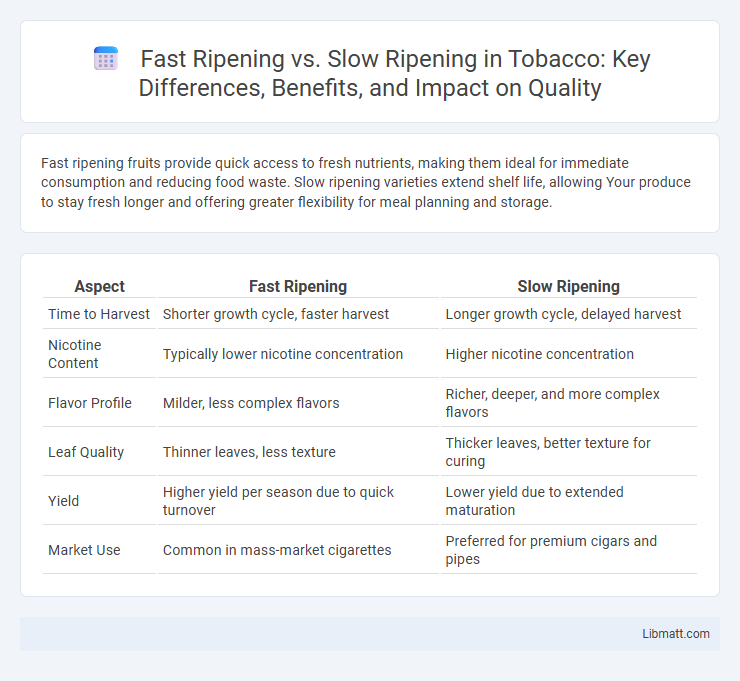Fast ripening fruits provide quick access to fresh nutrients, making them ideal for immediate consumption and reducing food waste. Slow ripening varieties extend shelf life, allowing Your produce to stay fresh longer and offering greater flexibility for meal planning and storage.
Table of Comparison
| Aspect | Fast Ripening | Slow Ripening |
|---|---|---|
| Time to Harvest | Shorter growth cycle, faster harvest | Longer growth cycle, delayed harvest |
| Nicotine Content | Typically lower nicotine concentration | Higher nicotine concentration |
| Flavor Profile | Milder, less complex flavors | Richer, deeper, and more complex flavors |
| Leaf Quality | Thinner leaves, less texture | Thicker leaves, better texture for curing |
| Yield | Higher yield per season due to quick turnover | Lower yield due to extended maturation |
| Market Use | Common in mass-market cigarettes | Preferred for premium cigars and pipes |
Introduction to Fruit Ripening Rates
Fruit ripening rates vary significantly between fast ripening and slow ripening varieties, affecting shelf life and flavor development. Fast ripening fruits like bananas and avocados quickly reach peak ripeness, making them ideal for immediate consumption but challenging for prolonged storage. Slow ripening fruits such as apples and citrus allow for extended preservation, giving you greater flexibility in timing consumption and reducing waste.
Defining Fast and Slow Ripening
Fast ripening refers to fruits or vegetables reaching maturity quickly, often within days to a couple of weeks, resulting in a shorter window for harvesting and consumption. Slow ripening involves a gradual maturation process over several weeks or months, allowing for extended storage and improved flavor development. Understanding the difference between fast and slow ripening helps you select produce that best suits your timing and quality preferences.
Biological Mechanisms Behind Ripening Speed
Fast ripening in fruits is driven by accelerated ethylene production and heightened respiratory activity, which intensify enzymatic processes such as pectin degradation and starch conversion. In contrast, slow ripening varieties exhibit delayed ethylene synthesis and reduced respiration rates, resulting in prolonged firmness and slower sugar accumulation. Genetic regulation of ethylene biosynthesis genes like ACS and ACO plays a critical role in determining the ripening speed.
Factors Influencing Ripening Time
Temperature, ethylene production, and fruit variety are key factors influencing ripening time, with higher temperatures and increased ethylene levels accelerating the process. Slow ripening occurs when these factors are minimized, often due to cooler storage conditions or specific genetic traits in the fruit. Your control over these variables can optimize ripening to suit market demand or consumption preferences.
Advantages of Fast Ripening Fruits
Fast ripening fruits offer the advantage of quicker availability for consumption, which meets urgent market demands and reduces storage time and costs. Their rapid maturation supports efficient supply chain turnover, minimizing spoilage and enhancing freshness for consumers. This accelerated ripening process also allows for multiple harvests within a single growing season, boosting overall agricultural productivity.
Benefits of Slow Ripening Varieties
Slow ripening varieties enhance flavor complexity and nutritional content by allowing fruits to mature gradually on the plant. This extended maturation period increases the synthesis of natural sugars, antioxidants, and vitamins, resulting in richer taste and higher health benefits. Additionally, these varieties often exhibit improved shelf life and better resistance to post-harvest diseases compared to fast ripening types.
Impact on Nutritional Value and Flavor
Fast ripening often results in fruits with lower nutritional value due to reduced time for accumulating vitamins and antioxidants, while slow ripening enhances nutrient density and flavor complexity by allowing natural sugars and phytonutrients to develop fully. Slow-ripened produce typically offers richer, more balanced taste profiles, boosting your culinary experience with heightened sweetness and acidity nuances. Selecting slow ripening fruits maximizes health benefits and superior flavor, ideal for gourmet meals and nutrient-focused diets.
Shelf Life and Storage Considerations
Fast ripening fruits typically have a shorter shelf life due to rapid biochemical changes and require immediate refrigeration to slow deterioration, preserving texture and flavor. Slow ripening fruits benefit from longer storage periods at controlled temperatures, allowing gradual flavor development while minimizing spoilage risk. Optimal storage conditions for slow ripening varieties include moderate humidity and consistent cool temperatures to extend freshness and shelf stability.
Fast vs Slow Ripening: Market Preferences
Fast ripening fruits appeal to markets demanding quick turnover and immediate consumption, ensuring fresher produce and reduced storage costs. Slow ripening varieties cater to markets prioritizing extended shelf life and transport durability, maintaining fruit quality over longer periods. Your choice between fast and slow ripening options depends on consumer preferences for freshness versus longevity.
Choosing the Right Ripening Rate for Your Needs
Fast ripening accelerates fruit maturation through controlled heat and ethylene exposure, ideal for meeting urgent market demands or reducing storage costs. Slow ripening preserves flavor complexity and nutrient content, suitable for gourmet produce and extended shelf life. Selecting the right ripening rate depends on balancing supply chain timing, quality standards, and consumer preferences.
Fast ripening vs Slow ripening Infographic

 libmatt.com
libmatt.com